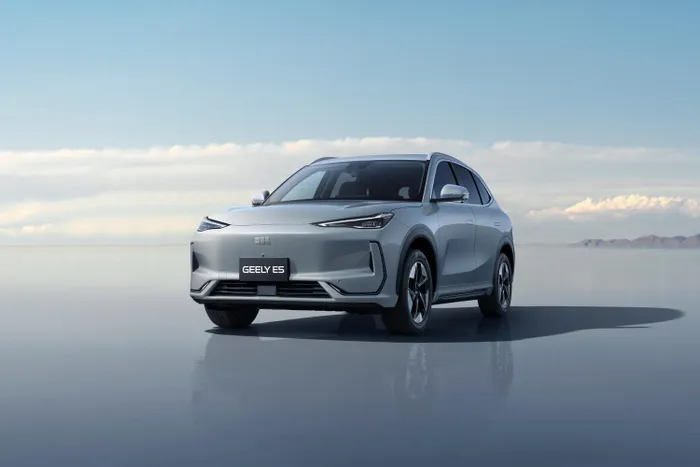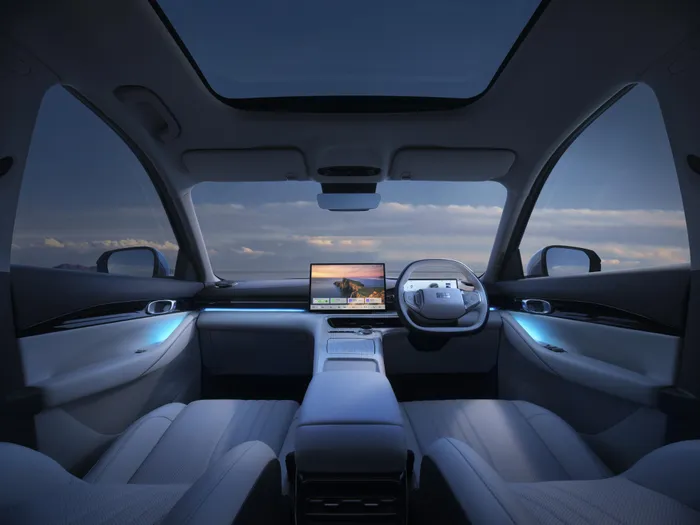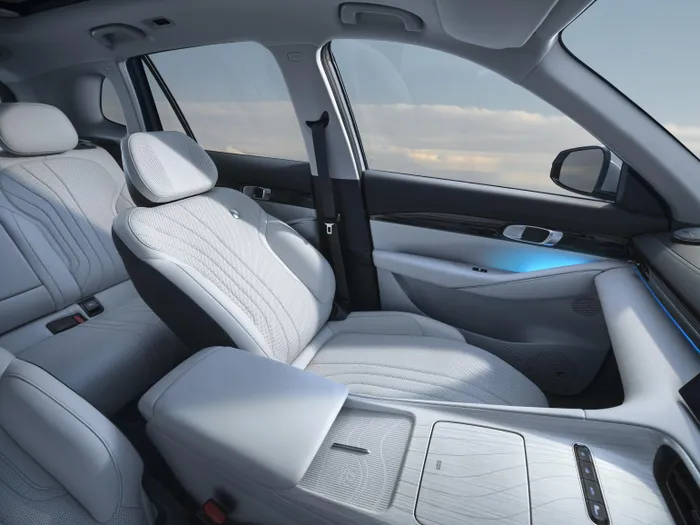Geely's second coming: Chinese auto giant brings E5 electric and hybrid SUVs to SA

Geely have returned to South Africa with the fully electric E5 and the plug-in hybrid E5 EM-i.
Image: Supplied
Geely has re-entered the South African market with electric and hybrid cars that form part of the brand’s new-energy expansion strategy.
You may recall the name from the early 2000s when they were represented through a joint venture with local firm TJM Holdings that was liquidated in 2007 and saw the brand disappear.
They’re certainly not a fly-by-night organisation but rather a privately-owned multinational company headquartered in Hangzhou, China. They have a majority stake in Swedish car maker Volvo, and their portfolio also includes Polestar, Lotus, Proton and Smart via a joint venture with Mercedes-Benz.
The two models they are venturing into the market with are the fully electric E5 and the plug-in hybrid E5 EM-i.
Exterior
Both models have a sleek, modern, and minimalist design, using Geely's "Rippling Light" design language.
Both variants feature smooth, sculpted body surfaces, hidden door handles and a prominent full-width taillight design at the rear. There are five colour options, and wheel sizes differ by trim, with 18-inch on Aspire and 19-inch low-drag alloys on Apex.

Both models have a sleek, modern, and minimalist design, using Geely's "Rippling Light" design language.
Image: supplied
BEV E5
The E5 comes in two grades, Aspire and Apex, and sits in the compact-to-mid-size SUV category.
Power is provided by a 60.22kWh battery and an 11-in-1 integrated electric drive unit with outputs of 160kW and 320Nm, giving it a claimed WLTP range of 430km and the Apex 410km with a top speed of 175km/h. It has a claimed 0-100km/h time of 7.1 seconds.
Charging from 30% to 80% takes about 20 minutes on a high-output DC charger, thanks to its 1.8C charging capability (the battery's ability to be charged at a current rate 1.8 times its total capacity). Vehicle-to-Load and Vehicle-to-Vehicle power output are standard.
Battery and safety
Geely says the E5’s Short Blade battery has been tested under severe conditions, including seawater immersion, extreme cold, structural crushing, underbody impacts and fire exposure. Geely claims no smoke, fire or thermal runaway occurred, and that parameters remain within spec after testing.
It’s designed for up to 3,500 cycles and retains a higher usable range in cold conditions than typical lithium-iron-phosphate packs.
Interior
As we’ve become accustomed to, the cabin features a multi-screen digital layout. A 15.4-inch central touchscreen, a 10.2-inch digital instrument cluster and a 13.8-inch head-up display (Apex) form a four-screen ecosystem when paired with a smartphone.
The system runs Flyme Auto, which includes voice control and fast processing through a 7-nm chipset.
The Apex receives a 1000W Flyme Sound audio system with 16 speakers, including headrest speakers and multiple directional tweeters. The Aspire uses a simpler system but retains the main interface.
The back seatbacks recline to two positions, and the front seats offer ventilation and massage functions depending on trim. There are 33 different storage areas, including a large hidden-bridge armrest box, a three-tier boot layout and a 51-litre sunken compartment with wet and dry separation.
Boot capacity is 461 litres, expanding to 1,877 litres when the rear seats are folded. The standard cabin uses a dark blue interior theme, with an optional ivory-white interior available.
On the safety front, the E5 is Geely’s first model to earn five-star results from both Euro NCAP and ANCAP.

The cabin features a multi-screen digital layout. A 15.4-inch central touchscreen, a 10.2-inch digital instrument cluster and a 13.8-inch head-up display.
Image: Supplied
E5 EM-i plug-in hybrid
South Africans seem to prefer hybrid options, and the E5 EM-i targets buyers who want electric driving capability without relying on charging infrastructure. It is built as a hybrid-first model and uses Geely’s EM-i (E-Motive Intelligence) powertrain.
The system pairs a 1.5-litre normally aspirated petrol engine with 73kW and 125Nm with an 11-in-1 electric drive unit producing a combined 160kW and 262Nm sent to the front wheels, and will get to 100km/h in eight seconds.
Thermal efficiency for the petrol engine is listed at 46.5% with Geely claiming a combined range of 943 kilometres.
The 18.4kWh LFP battery supports AC charging at 6.6 kW and DC charging at 30 kW. A 30%–80% DC charge takes about 20 minutes. Vehicle-to-Load functionality is standard with up to 6kW power output. The E5 EM-i’s performance is not impaired when the battery is low because the system blends petrol and electric power automatically.
There are three driving modes: Pure (electric), Hybrid and Power. Pure mode provides BEV-type driving for shorter commutes, while Hybrid optimises fuel use, and Power gives maximum combined output for overtaking or highway gradients.
Interior
Inside, it uses the same “Golden Triangle” screen layout with a 15.4-inch touchscreen, 10.2-inch instrument cluster and on the Apex, a 13.8-inch HUD.
Wireless Apple CarPlay is standard, with Android Auto confirmed for Q1 next year via over-the-air updates. Both versions use an ebony-black cabin theme, with ivory white reserved for the Apex.
The Aspire variant includes six speakers, LED lighting, 18-inch wheels, climate control and a surround-view camera. Apex adds a panoramic roof, 16-speaker Flyme audio, 19-inch wheels, ambient lighting, a power tailgate, and memory and ventilation functions for the front seats.
Driving
We first slipped in behind the wheel of the E5 for the launch drive in and around Midrand and Sandton.
Our test unit was fitted with the ivory white interior, and while it creates an atmosphere of executive sophistication, we reckoned that with regular use by a family with kids, it’s likely to quickly become scuffed and dirty after a few thousand kilometres.
The seats are extremely comfortable and supportive, with the passenger seat folding back with leg support like a La-Z-Boy. The interior feels especially roomy for a car in this segment.
When electric cars first arrived, everyone was enamoured by their blistering acceleration. Thankfully, that has passed, and the E5, although not slow off the mark, provides smooth and linear acceleration.
They have done a decent job regarding sound isolation with very little tyre or wind noise, especially at lower speeds and only a hint at 120km/h.
Driving at slow speeds through traffic as we negotiated the government’s attempts at convincing G20 Summit delegates that all is well in Joburg, it sounded like there was a constant lullaby in the background that we couldn’t get rid of.
Turns out, because of legislation in certain countries, that under 15km/h, a silent electric car needs to warn pedestrians of its presence.
The 10.2-inch instrument cluster provides all the information you need, but it does look a little undersized behind the steering wheel and will take some time to get used to.
The E5 EM-i has a similar architecture and feel to it.
Like its BEV sibling, fortunately, there are dials and buttons for air conditioning and sound, so you don’t have to delve deep into the screen to adjust them.
As expected, it doesn’t have the same acceleration, and when pressed hard, there is a whine from the engine as it transfers the power. Cruising along, though, it’s quiet and refined.
As with many Chinese cars, there’s a plethora of warning sounds, including an irritating ping the moment the car goes over the speed limit.
While it’s not a bad thing, we all know that in South Africa, things can be a bit fluid, and when you’re doing 65km/h passing someone, the noise becomes intrusive.
After some deep diving into the settings, we managed to switch it off, which provided a far less stressful drive.

The passenger seat folds back with leg support like a La-Z-boy.
Image: Supplied
Safety
Both the E5 and E5 EM-i run an L2-level driver assistance package that includes automatic emergency braking, adaptive cruise control, intelligent cruise control and lane keeping assist. Crash preparation software automatically activates hazard lights, unlocks doors and extends exterior handles after a severe impact.
Every E5 purchase includes a home wallbox and R10,000 public charging credit. The E5 EM-i also receives a wallbox and R5,000 public charging credit.
Both models fall under the Geely Care+ support structure with a six-year/150,000km warranty, while the battery warranty is eight years/200,000km. The E5 includes a six-year/120,000km service plan, and the EM-i a five-year/75,000 km plan. Roadside assistance runs for five years with unlimited distance.
Pricing
- E5 Aspire: R699 999.
- E5 Apex: R759 999.
- E5 EM-i Aspire: R599 999.
- E5 EM-i Apex: R679 999.
Related Topics: